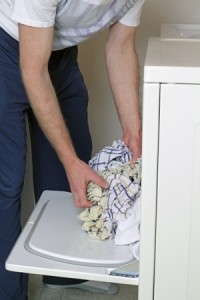 According to the National Fire Protection Association, nearly 17,000 house fires were caused by clothes dryers and washing machines in the United States in 2010. This accounts for roughly 4.5% of all the house fires in the country that year. Many of these fires were the result of clogged or improperly installed dryer vents that went unnoticed by homeowners. These vents are designed to remove residual moisture from your house during the drying process, but if neglected they can constitute serious fire hazards. Today, we’ll help you inspect and evaluate the safety of the dryer vent in your home.
According to the National Fire Protection Association, nearly 17,000 house fires were caused by clothes dryers and washing machines in the United States in 2010. This accounts for roughly 4.5% of all the house fires in the country that year. Many of these fires were the result of clogged or improperly installed dryer vents that went unnoticed by homeowners. These vents are designed to remove residual moisture from your house during the drying process, but if neglected they can constitute serious fire hazards. Today, we’ll help you inspect and evaluate the safety of the dryer vent in your home.
Check Connections
Pull your dryer out and make sure that they dryer exhaust hose is, in fact, connected to the dryer. Typically the connection is located on the back of the dryer, but on some models it may be located beneath it. If the exhaust vent becomes disconnected, moisture will linger in your laundry room and flammable dryer lint will begin to accumulate within the back of the dryer. That additional moisture can promote mold growth in your home, while the dryer lint can easily cause fires.
Check for Kinks
Ideally, the exhaust hose behind your dryer shouldn’t be any longer than it needs to be. Long, loose lengths of hose are prone to kinks and twists that restrict the flow of air and moisture out of your home. As lint becomes trapped in the kinks in the hose and the airflow becomes further restricted, heat can build up in your dryer and eventually trigger fires.
Make Sure the Exhaust Terminates Outside
Sometimes, lazy installers will vent dryer exhaust into an attic or crawl space rather than the exterior of a home. Dryer exhaust must be vented outside and away from your home in order to avoid mold growth and minimize the chance of fire. Find out where your dryer exhaust terminates, and if it’s not outside your home take steps to have it rerouted as soon as possible. Please note that the total length of the exhaust hose should not exceed 25 feet in order to ensure adequate airflow.
The end of your exhaust vent should be fitted with a backdraft damper, but it should not be fitted with a screen. These screens accumulate stray lint and can become serious fire hazards if left unattended. Check the end of your exhaust vent periodically and clear any built-up lint deposits.
Here at First Choice Inspectors, we know how important it is for homeowners to stay mindful of this important maintenance item. If you’re concerned about the safety of your dryer vent, don’t wait for it to become a serious hazard. Give us a call today and gain the peace of mind of knowing your home is protected from dryer vent fires.